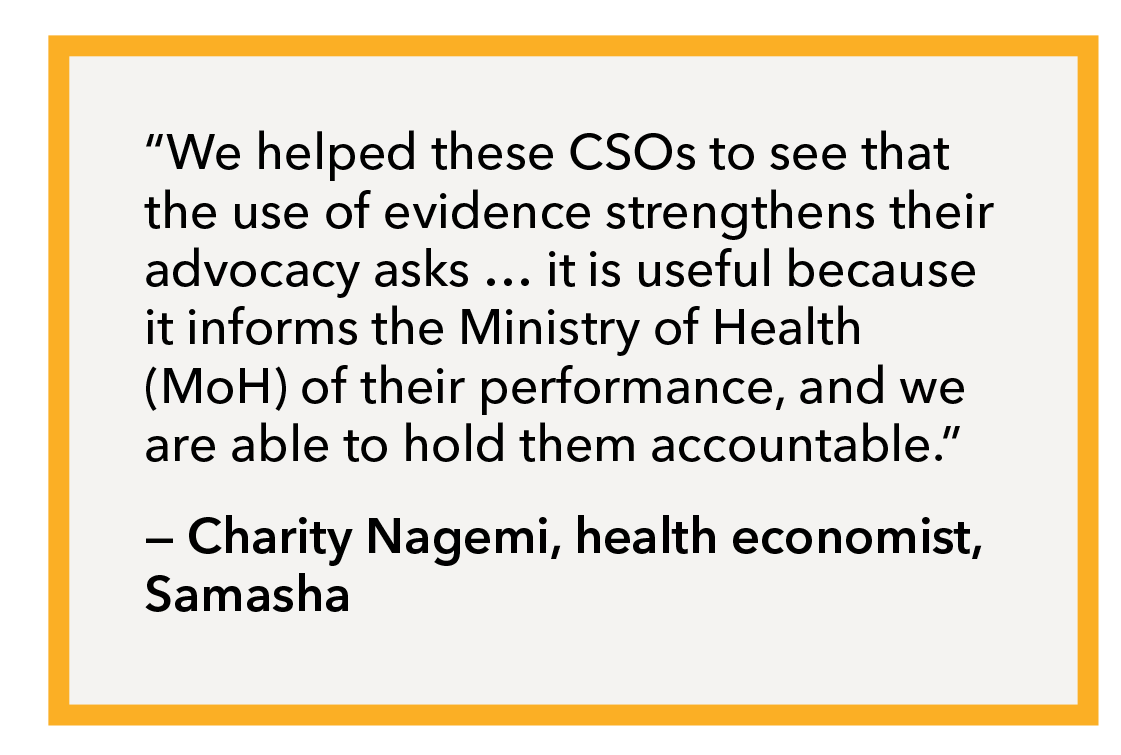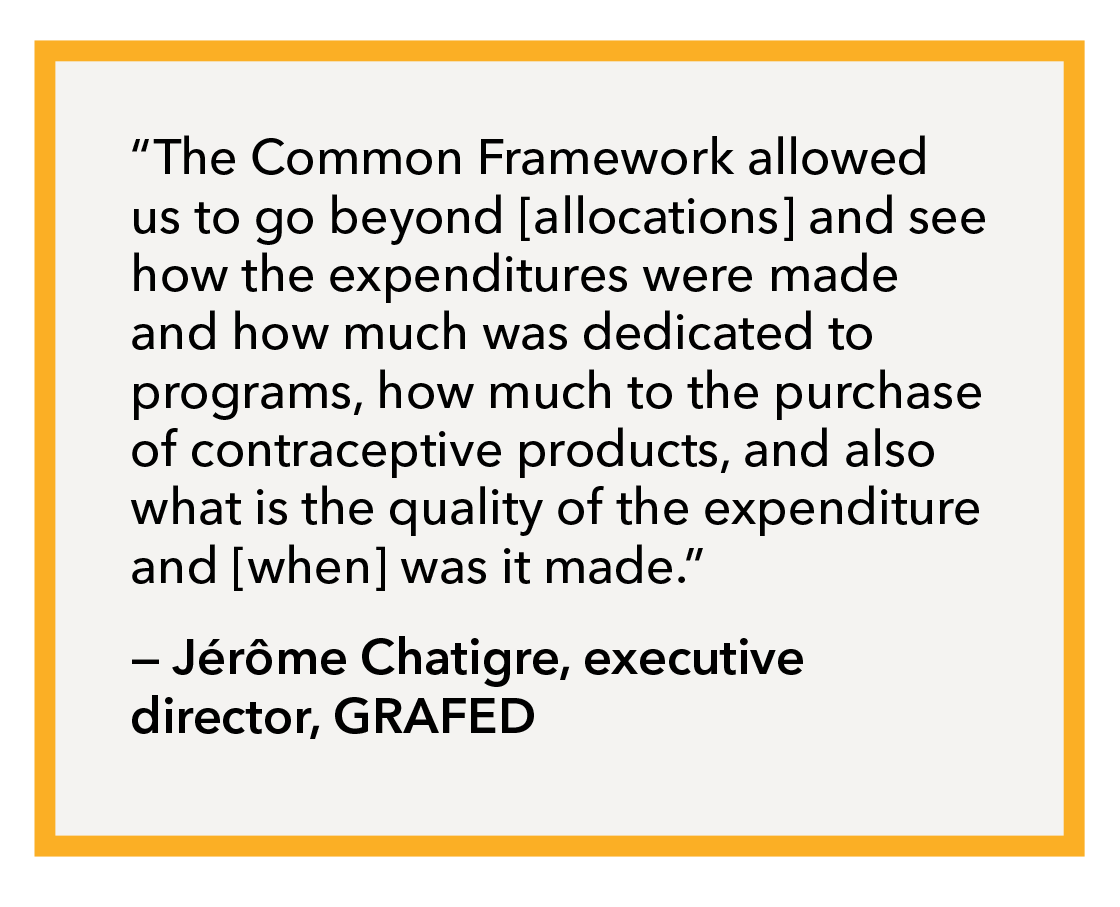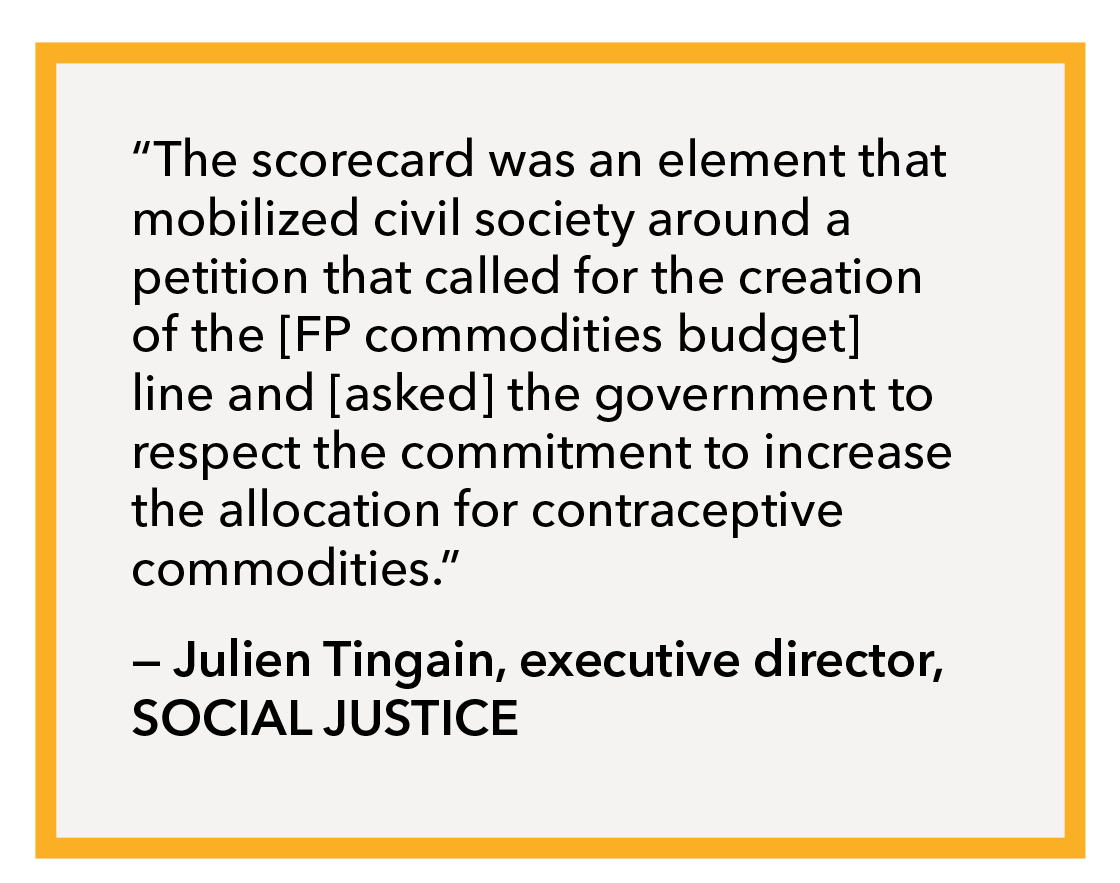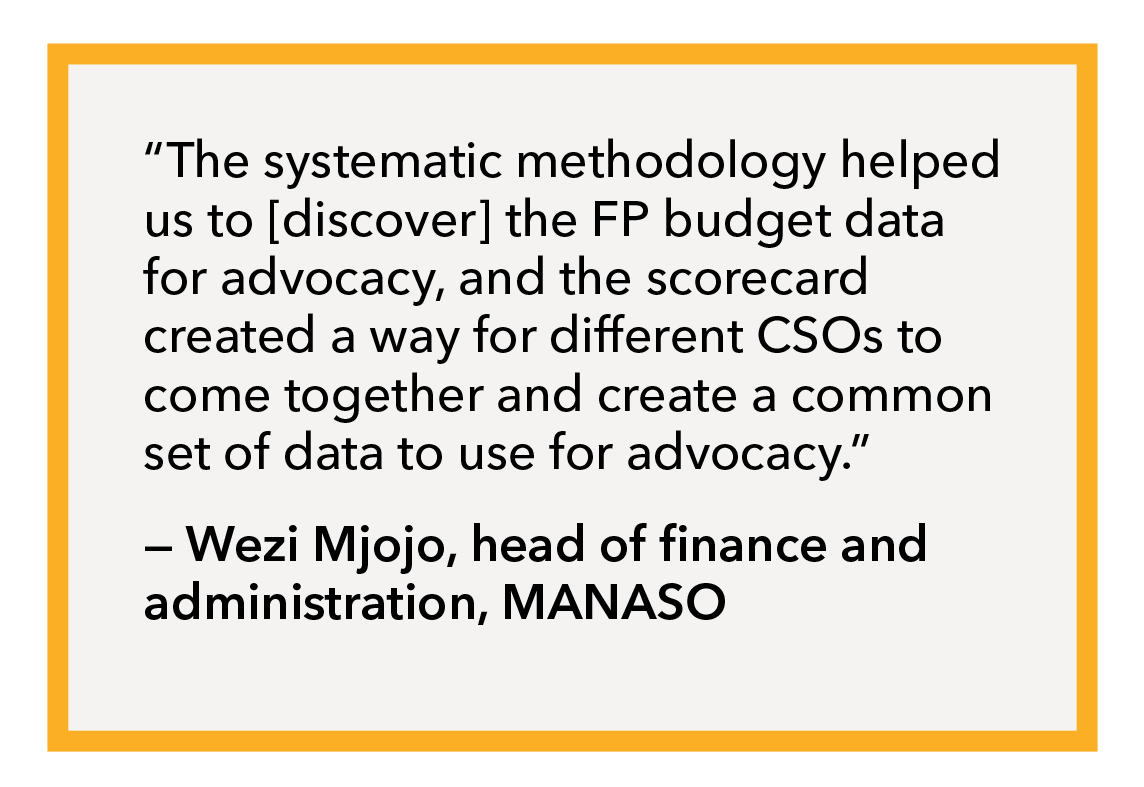Launch of FY 2019/20 and FY 2020 Family Planning Budget Scorecards

Join PAI’s #HERVoice campaign to uplift inspiring women who are making a difference around the world. Learn more
Developed in partnership with PAI by civil society organizations (CSOs) — including Samasha in Uganda, the Centre for Reproductive Health and Education (CRHE) in Zambia and Malawi Network of AIDS Service Organisations (MANASO) — the Common Framework for Tracking Government Spending on Family Planning (FP) is an approach that holds governments accountable for meeting their commitments to fund FP supplies and service. Data collected using the Common Framework are summarized in FP budget scorecards, easy-to-understand visual snapshots that illustrate how much governments are actually allocating and spending on FP as well as how transparent the government is in making FP budget data available to the public. This blog captures the experiences of four organizations using the FP budget scorecards to present findings and achieve their advocacy goals.
Getting policymakers to make meaningful policy and budgetary commitments for FP is hard enough — building sufficient momentum and political goodwill to enshrine law can take years to bring to fruition. But those commitments mean nothing if they’re not actualized or if spending isn’t transparent. So, how do advocates hold their leaders accountable in a coordinated way that enables them to maximize their voices?
To address this challenge, for the past four years, CSOs in Benin, Burkina Faso, Côte d’Ivoire, Malawi, Tanzania, Uganda and Zambia have used the Common Framework for Tracking Government Spending on Family Planning. This approach holds governments accountable for meeting their commitments to fund FP supplies and services by increasing and spending the domestic resources they’ve allocated while improving the transparency of budget data.
Developed in partnership with PAI by CSOs — including Samasha in Uganda, CRHE in Zambia and MANASO in Malawi — the Common Framework has a standard set of indicators that CSOs can use to track their government’s planning and budgeting cycle, from estimating resource needs to resource allocation, disbursement, expenditure and outcomes. Data collected using the Common Framework are summarized in FP budget scorecards, easy-to-understand visual snapshots that illustrate how much governments are actually allocating and spending on FP in relation to estimated funding needs, as well as how transparent the government is in making FP budget data available to the public.

At the end of November 2022, PAI hosted the virtual launch of the third annual FP budget scorecards for the seven countries, developed by CSO partners of the Government Accountability for Family Planning Budgets project. The launch featured speakers from four partner organizations who shared their experiences collecting FP budget data and using the scorecards to present findings and highlighted their advocacy efforts and wins.
During the event, partners discussed three key themes that emerged from their experiences:
Advocacy Strengthening
While using the Common Framework, partners discovered that their advocacy started while collecting FP budget data, long before they developed their scorecards. Data collection provided partners with a legitimate entry point for engaging with their governments and required relationship-building with policymakers, which laid the foundation for FP budget advocacy.
Partners raised policymakers’ awareness on the reasons for data collection, their FP budget advocacy objectives and the importance of FP budget transparency. Validating the data with policymakers demonstrated the partners’ commitment to credibility and collaborating with governments, which gave weight to their ultimate advocacy asks.
Once PAI’s partners produced the scorecards, they found it beneficial to collaborate with other local CSOs to jointly analyze the data and coordinate on advocacy. This led to the development and strengthening of FP budget coalitions and advancing of common evidence-based agendas and messages.
Partners testified that the scorecard evidence also facilitated access to new advocacy spaces, such as technical working groups and committees. It also brought about alliances with government and nongovernment accountability actors, such as agencies in charge of implementing access to information laws and the Open Government Partnership (OGP).
Successes Achieved 
Partners also recounted concrete advocacy wins that were achieved using the scorecards as their evidence base. Jérôme Chatigre shared that Groupe de Recherche, d’Action et de Formation en Épidémiologie et en Développement (GRAFED) and Social Watch Benin played a leading role in advocacy that led to a 20% increase in the budget for FP commodities — well above the 10% per year pledged under the country’s FP2030 commitments. Their advocacy also led to an FP commodities budget line being added to the MoH’s fiscal year (FY) 2022 budget.

Julien Tingain of Initiative pour la Justice Sociale, la Transparence et la Bonne Gouvernance en Côte d’Ivoire (SOCIAL JUSTICE) described how its advocacy and the evidence captured in the scorecards resulted in the government committing to creating and including an FP commodities budget line in Côte d’Ivoire’s OGP National Action Plan 2020-2022, implemented in FY 2022, and regularly publishing FP budget data on the MoH website.
According to Wezi Mjojo, once MANASO started budget tracking, it not only found that the amount allocated for FP commodities was increased only minimally each year, but that the allocation as a percentage of the funding need had actually declined. After MANASO organized coalition meetings with MoH and Ministry of Finance (MoF) officials, the MoH increased the commodities allocation by 125% in FY 2019/20. During the FY 2020/21 budget formulation, a decision was made to decrease the commodities allocation by 10 million Malawian kwacha (nearly $10,000) due to the need to divert funding to the COVID-19 response. MANASO and the coalition mobilized, and their advocacy resulted in a 9% increase in the FP commodities budget for FY 2020/21.
Due to Samasha’s tracking and advocacy over the last four years, Uganda’s FP programs budget tripled between FY 2018/19 and FY 2019/20 and increased by 53% between FY 2019/20 and FY 2020/21. Samasha also achieved policy-level changes when its advocacy objective — that 50% of the reproductive health department budget goes to FP commodities — was adopted as a key pillar of Uganda’s FP2030 commitments. Its advocacy also led to the inclusion of increased domestic funding for FP programs in Uganda’s five-year FP costed implementation plan (2020/21-2024/25).
Data Collection Challenges
All four partners noted common data collection challenges that point to major gaps in the public availability of FP budget data, while emphasizing the critical role that data collection plays in the advocacy process, leading to increased transparency over time due to the building and nurturing of relationships with government officials.
Chatigre described the difficulty in accessing quarterly data in Benin and noted that MoF officials explained that the first disbursement of an allocation must be fully spent before the MoF can release the second disbursement, meaning that disbursements do not follow a consistent schedule. Another equally important factor is that the revenue from which allocations are drawn must first be generated before those funds can be disbursed, which causes delays in disbursements.
In the Côte d’Ivoire context, Tingain ascribed the main challenge at the initial stages of data collection to the lack of a specific FP commodities budget line from which disbursements and expenditures could be tracked. In addition, quarterly data are not available to assess the timeliness and adequacy of disbursements and expenditures during a fiscal year. When meeting with MoH and MoF officials, SOCIAL JUSTICE also found these officials were reluctant to provide data. Since then, it has succeeded in securing the FP commodities budget line in FY 2022, ensuring that the budget tracking process has improved despite ongoing challenges with accessing expenditure data.
Nagemi explained that accessing FP commodities expenditure data in Uganda has seen similar improvements, as Samasha is able to get receipts from the National Medical Stores. Quarterly disbursement data are available, but only for reproductive health items, which combines maternal health and FP commodities. FP programs’ allocation and expenditure data are aggregated with other health programs (maternal health, immunization, etc.), making it impossible to know how much is allocated, disbursed and spent on FP programs alone.
Starting this year, PAI and its partners will use country-validated data on global platforms like the World Health Organization System of Health Accounts, Track20’s Family Planning Spending Assessment and the United Nations Population Fund’s Family Planning Expenditures Tracking Surveys to address some of these challenges and improve data validation and triangulation.
Lessons Learned and Next Steps
Achieving universal access to FP services requires reliable budget allocations that increase each year in relation to the estimated funding need and guaranteed disbursements and expenditure at all levels of government. CSOs can bring about tangible improvements in the management of FP finances and thus FP service delivery by tracking funds through the budget cycle, using evidence-based advocacy with policymakers and strengthening community accountability structures.
PAI’s Government Accountability for Family Planning Budgets project partners have attested that the Common Framework and scorecards provide them with:
They have also demonstrated that by using the Common Framework to track funds and produce scorecards, CSOs can make a rigorous, evidence-based case for domestic investment in FP, with messages highlighting how sustained and/or increased funding is a cost-effective way to save lives, improve public health outcomes and contribute to achieving priority development goals and commitments.
Continuous and increased investment in FP budget tracking and scorecards like this is needed. These tools would have an even greater impact if national-level budget tracking was accompanied by community monitoring of FP commodity and service availability as well as the quality of services at the point of delivery. Budget tracking and service delivery monitoring are essential to generating the evidence needed to hold governments accountable for their commitments to invest in FP and ultimately bringing about the changes needed to improve the lives of people across sub-Saharan Africa.
Stay informed about the issues impacting sexual and reproductive health and rights.